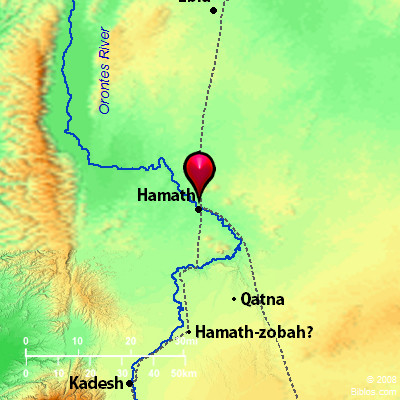Atlas  Hamath and surrounding area Maps Created using Biblemapper 3.0 Additional data from OpenBible.info Occurrences 2 Samuel 8:9 When Toi king of Hamath heard that David had struck all the army of Hadadezer,2 Kings 14:28 Now the rest of the acts of Jeroboam, and all that he did, and his might, how he warred, and how he recovered Damascus, and Hamath, which had belonged to Judah, for Israel, aren't they written in the book of the chronicles of the kings of Israel? 2 Kings 17:24 The king of Assyria brought men from Babylon, and from Cuthah, and from Avva, and from Hamath and Sepharvaim, and placed them in the cities of Samaria instead of the children of Israel; and they possessed Samaria, and lived in the cities of it. 2 Kings 17:30 The men of Babylon made Succoth Benoth, and the men of Cuth made Nergal, and the men of Hamath made Ashima, 2 Kings 18:34 Where are the gods of Hamath, and of Arpad? Where are the gods of Sepharvaim, of Hena, and Ivvah? Have they delivered Samaria out of my hand? 2 Kings 19:13 Where is the king of Hamath, and the king of Arpad, and the king of the city of Sepharvaim, of Hena, and Ivvah?"'" 2 Kings 23:33 Pharaoh Necoh put him in bonds at Riblah in the land of Hamath, that he might not reign in Jerusalem; and put the land to a tribute of one hundred talents of silver, and a talent of gold. 2 Kings 25:21 The king of Babylon struck them, and put them to death at Riblah in the land of Hamath. So Judah was carried away captive out of his land. 1 Chronicles 18:9 When Tou king of Hamath heard that David had struck all the army of Hadadezer king of Zobah, 2 Chronicles 8:4 He built Tadmor in the wilderness, and all the storage cities, which he built in Hamath. Isaiah 10:9 Isn't Calno like Carchemish? Isn't Hamath like Arpad? Isn't Samaria like Damascus?" Isaiah 11:11 It will happen in that day that the Lord will set his hand again the second time to recover the remnant that is left of his people from Assyria, from Egypt, from Pathros, from Cush, from Elam, from Shinar, from Hamath, and from the islands of the sea. Isaiah 36:19 Where are the gods of Hamath and Arpad? Where are the gods of Sepharvaim? Have they delivered Samaria from my hand? Isaiah 37:13 Where is the king of Hamath, and the king of Arpad, and the king of the city of Sepharvaim, of Hena, and Ivvah?'" Jeremiah 39:5 But the army of the Chaldeans pursued after them, and overtook Zedekiah in the plains of Jericho: and when they had taken him, they brought him up to Nebuchadnezzar king of Babylon to Riblah in the land of Hamath; and he gave judgment on him. Jeremiah 49:23 Of Damascus. Hamath is confounded, and Arpad; for they have heard evil news, they are melted away: there is sorrow on the sea; it can't be quiet. Jeremiah 52:9 Then they took the king, and carried him up to the king of Babylon to Riblah in the land of Hamath; and he gave judgment on him. Jeremiah 52:27 The king of Babylon struck them, and put them to death at Riblah in the land of Hamath. So Judah was carried away captive out of his land. Ezekiel 47:16 Hamath, Berothah, Sibraim, which is between the border of Damascus and the border of Hamath; Hazer Hatticon, which is by the border of Hauran. Ezekiel 47:17 The border from the sea, shall be Hazar Enon at the border of Damascus; and on the north northward is the border of Hamath. This is the north side. Ezekiel 48:1 Now these are the names of the tribes: From the north end, beside the way of Hethlon to the entrance of Hamath, Hazar Enan at the border of Damascus, northward beside Hamath, (and they shall have their sides east and west), Dan, one portion. Amos 6:2 Go to Calneh, and see; and from there go to Hamath the great; then go down to Gath of the Philistines. are they better than these kingdoms? or is their border greater than your border? Zechariah 9:2 and Hamath, also, which borders on it; Tyre and Sidon, because they are very wise. Encyclopedia HAMATHha'-math (chamath; Hemath, Haimath; Swete also has Hemath): The word signifies a defense or citadel, and such designation was very suitable for this chief royal city of the Hittites, situated between their northern and southern capitals, Carchemish and Kadesh, on a gigantic mound beside the Orontes. In Amos 6:2 it is named Great Hamath, but not necessarily to distinguish it from other places of the same name. HA'MATH, fortress, one of the oldest cities in Syria, Gen. 10:18, wherein Hamathite means inhabitant of Hamath. Its importance was signified by Amos (6:2) who calls it "the great". Now called Hamah, 245 ms. n. by e. from Jerusalem, on the river Orontes. Its population is 44,000. The "entrance of Hamath" is the pass through the mountains of Lebanon on the south. Strong's Hebrew H2574: Chamatha place North of Damascus |



